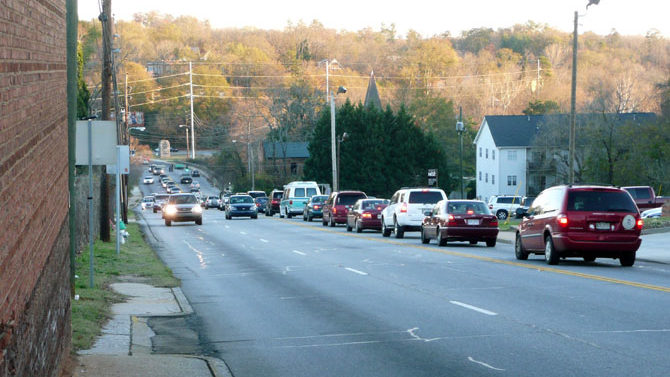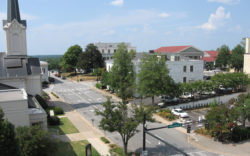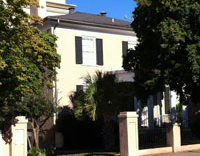I’ve been mulling over T-SPLOST for awhile now. I’ve tried to find a good side in it, from the claims of new construction jobs to new bike lanes and bus service, but all I really see is a new, regressive subsidy for sprawl. While the strategy involved in crafting the project list was to provide something for everyone in order to build the most support possible, it seems likely that the net effect on traffic in the Classic City won’t be that great.
The widening of rural highways like Lexington and Winterville roads will do little to solve urban gridlock, and will likely exacerbate it by encouraging more driving in from rural areas, without addressing the congestion on the narrow urban streets that actually connect those rural roads to employment centers like hospitals and the university. Infrastructure like roads, sewer and schools drives growth as much as zoning, and the widening of these rural corridors will simply encourage more scattered development in the greenbelt, where public services from education to fire and police protection are more expensive to provide.
Four-laned Jefferson Highway has been the recipient of many proposals for big commercial developments along it recently, particularly major shopping centers in the Moss Side and Oak Grove neighborhoods. The construction of a host of wide, new roads in Oconee County centered on the Epps Bridge interchange was conducted specifically with the intention of spurring commercial growth. It’s hard to imagine any local road with that four- or five-lane profile that hasn’t ultimately been lined with apartments and commercial strips. Consider the evolution of Barnett Shoals Road over the past decade or so, and the acres and acres turned over for new apartments. Could T-SPLOST be the road to the Gwinnettification of Athens? It seems fairly likely.
Big suburban arterials like these are the backbone of sprawl landscape across the country, and we’re quite delusional if we expect anything different to happen here. The new interchanges and roads on either side of the Atlanta Highway will likely have the same effect, creating the familiar grid of superblocks that characterizes places like Phoenix. A lot of other progressive things will have to happen for roads like Jennings Mill to become anything other than suburban commercial strips, so expect the status quo.
Traffic abhors a vacuum, and will, as it does everywhere else, swell to meet capacity. As the 16-lane highways of Atlanta show, we can’t pave our way out of congestion. Thankfully, there are a few token bike lanes thrown into this T-SPLOST package to calm noisy alternative transportation advocates, but those would seem to be a wash, too. Bike lanes on Lexington are not likely to make much of a difference until the character of that road changes fundamentally. Few are likely to take up cycling when cars are whizzing by their elbows at 60 miles an hour. North Avenue, with its huge hill and canyon of retaining walls, seems another unlikely site for a cycling revolution.
Prince Avenue is the one place where bike lanes could actually make a tangible difference, with heavy ridership already linking major employment centers on a flat corridor. Unfortunately, the corridor is highly constricted by street-fronting commercial buildings, tight sidewalks and street trees, and on-street parking. Will the Georgia Department of Transportation, which has the ultimate say in how that project is carried out, carefully weave all these uses together, maintaining the corridor’s existing ambience, or plow through, wiping out on-street parking, beautiful shade-giving dogwoods and any chance at a true urban boulevard? Trees and parking slow cars down, and if it’s handled poorly, the result might be a road that’s less safe for bikes due to increased speeds, despite a little asphalt especially for them. It’s a big gamble, and one of the reasons why commissioners took Milledge Avenue off the list of potential projects.
Are these projects on the whole really as essential as claimed, or are they more likely just nice-to-haves favored by GDOT’s engineers in Atlanta? Our share of the project money is roughly proportional to the population, or perhaps a little less, with smaller and more urban counties subsidizing large rural counties like Madison. Minus that subsidy, this is functionally a local SPLOST, with projects like a $25 million interchange at Mitchell Bridge, $18 million to widen Tallassee Road and $15 million to widen portions of Olympic Drive and Winterville Road. Viewed as such, would it pass? Unlikely. Some smaller projects, like the intersection of Whitehead and Tallassee roads, might indeed be seen more favorably, but the reality is that the list was drafted primarily by out-of-town engineers and politicians, with a touch of input from our mayor and one county commissioner.
This 10-year tax, if passed, will affect our region for a generation. Unfortunately, its origins—both in the Legislature, where T-SPLOST was devised, and at the local roundtable, where the project list was hammered out—are less than visionary, and so seem unlikely to produce any real results. T-SPLOST is a Band-Aid on the state’s transportation problems, and the roundtable’s list is a list of Band-Aid projects. Real and comprehensive transportation solutions for the region aren’t coming from this program, no matter how much we may like a few particular projects.
Like what you just read? Support Flagpole by making a donation today. Every dollar you give helps fund our ongoing mission to provide Athens with quality, independent journalism.










